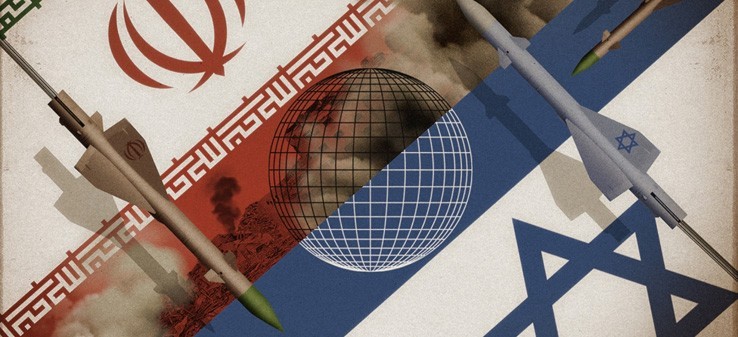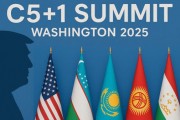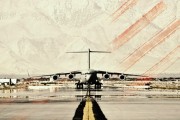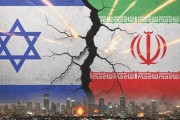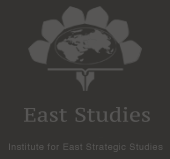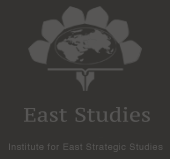Publish Date
Tuesday 26 August 2025 - 13:17
recommended
0
Central Asia's discourses to US and Israel’s Aggression on Iran
Reassessing Transit Routes: Central Asia's discourses to US and Israel’s Aggression on Iran
It must be acknowledged that Central Asia’s concerns regarding transit are, to a certain degree, both “real” and “natural,” and therefore deserve attention and clear responses over time. At the same time, another part of the reality lies in the “exaggeration” of this situation, driven mainly by Western discourse-making. It should also be noted that some secondary actors, such as the Taliban, Azerbaijan, and Turkey, are seeking to maximize their positions and interests under the current conditions.
By: Omid Rahimi
9 minutes reading
9 minutes reading
| What you read in this report: 1.Introduction 2.Iran’s Transit Significance for Central Asia 3.Central Asia's Transit Discourse Post-Aggression 4.Possible Implications 5.Conclusion: Future Imperatives |
Introduction
For landlocked Central Asian states, diversifying transit access is a national security imperative and a core component of their survival strategies. This critical need elevates the diversification of transit routes into a vital element of their foreign and domestic policy, as well as their economic development programs. Consequently, reactions to developments affecting these routes are typically swift, serious, and strategically calculated.
From this perspective, Central Asia’s response to the aggression by the Zionist regime and the United States against Iran can be analyzed through the lens of transit policy, given Iran's role as a key access route for the region. Over the past month, distinct narratives have emerged in Central Asia concerning this issue, which can be examined from multiple angles. These discourses could potentially lead to the emergence or reinforcement of specific foreign policy outcomes. Simultaneously, understanding these narratives is crucial for shaping the future of Iran–Central Asia relations.
Iran’s Transit Significance for Central Asia
Appreciating the nuances of Central Asia’s transit discourse post-aggression requires an assessment of Iran’s strategic transit position. As a landlocked region, Central Asia must traverse one or two countries and over a thousand kilometers to reach open waters. This results in transportation costs approximately 30% higher than global averages, diminishing competitive advantage, increasing dependency, and constraining trade.
Central Asia theoretically has five potential sea access routes: through China, Russia, across the Caspian Sea and the South Caucasus, through Afghanistan, and via Iran. In practice, the Afghan route remains unusable due to security instability, and the Chinese route is hampered by a lack of economic feasibility. Access to the Black Sea via the South Caucasus has proven uneconomical and is severely capacity-constrained. The Middle Corridor’s current capacity is a mere 4 million tons—insufficient even for a single Central Asian country. Even its projected capacity of 10 million tons in the next decade holds little real attraction beyond political rhetoric. For instance, in the first nine months of 2023, Kazakhstan utilized only 2 million tons of this route, a mere 6.8% of its total non-oil and gas transit volume of 29 million tons. Usage by other Central Asian countries and China is even lower.
Historically, Russia has been the primary transit corridor for Central Asia, attractive due to its robust infrastructure and low costs. However, severe Western sanctions on Russia and Central Asia’s apprehension about being accused of sanctions evasion have weakened this route's reliability. Despite this, reports indicate that in 2024, Kazakhstan alone moved 110 million tons of transit via Russia, 88% of which was oil, with 14 million tons comprising other goods. This volume alone surpasses the entire future projection for the Middle Corridor.
Russian officials reported a total transit volume of 1.2 billion tons in 2023, with 70% moved by rail, serving both Russian needs and those of China and Central Asia. This underscores that, sanctions notwithstanding, Russia remains a critical transit option.
Iran presents another route. While not directly competitive with Russia's volume, it is far more attractive than the Afghan or South Caucasus options. It offers the shortest path for Central Asia to reach open ocean waters, positioning it as the potentially fastest and most cost-effective route.
According to Iranian Customs, transit through Iran grew by roughly 20% in 2023, reaching 22 million tons. The most significant growth occurred at border crossings like Lotfabad and Sarakhs, which handle trade with Central Asia. Iranian officials report that the operational capacity of the Sarakhs and Incheboron rail corridors is currently 6–7 million tons annually. With recently signed agreements with Turkmenistan, this capacity is expected to rise to 16 million tons within three years and later to 20 million tons. Thus, Iran stands as a crucial and rapidly growing transit access route for Central Asia.
Central Asia's Transit Discourse Post-Aggression
Following the aggression by Israeli Regime and the US against Iran, a predominant narrative in Central Asia framed the conflict as a battle against a China-Russia-Iran alliance. From a realist perspective, regional actors acknowledged their limited capacity to influence the situation but argued that through supplementary measures, they could mitigate the associated costs of the tensions.
The prevailing view was that small states cannot affect the outcomes of battles between international and regional powers; their role is to await the result and adapt accordingly. Within this discursive environment, the primary concern (after immediate security) was the security of international transit corridors. A segment of Central Asia’s transit outlook had previously held positive expectations for Iran's role, which now came under scrutiny.
Immediately after the aggression began, the Uzbek government convened an emergency meeting and decided to redirect transit cargo toward ports and logistics centers perceived as safer. Uzbekistan’s Deputy Transport Minister concurrently stated that Middle East tensions could adversely impact logistics globally and in Central Asia.
Similarly, Kazakhstan’s Minister of Economy informed the country’s Senate that growing insecurity along the Iranian rail corridor had prompted Astana to prepare to strengthen alternative routes. He contended that a shift to multimodal routes would not drastically affect prices, as these are set globally.
However, Kazakh media reported that the tensions directly impact a recent Iran-Kazakhstan agreement on transiting 3 million tons of grain. In Tajikistan and Kyrgyzstan, Iran's transit situation was examined through a similar lens, primarily in media coverage.
One of the first official international forums where these discourses surfaced was the ECO Summit in Khankendi, Azerbaijan. There, Uzbek President Shavkat Mirziyoyev emphasized that the current geopolitical situation makes attention to alternative transit routes essential. Other Central Asian and South Caucasus officials used this platform to stress the importance of new corridors like the Trans-Afghan and Trans-Caspian routes—a move interpreted as an implicit, and sometimes direct, response to Iran’s new circumstances.
While such ideas might have been proposed regardless, linking them to Iran’s security situation lent them a greater air of pragmatism. In the conflict's aftermath, Kazakhstan’s Prime Minister announced Astana's interest in investing in the Torghundi–Herat corridor and a logistics center in Herat, with Afghan sources citing a potential investment of around $500 million. Russian officials aligned with this approach; Deputy Prime Minister Alexei Overchuk discussed eastern and western routes within the North–South Corridor, with the eastern route based in Afghanistan. Russia’s de facto recognition of the Taliban government during this period can be seen as supporting this orientation.
In media and expert circles, several other discursive themes took shape:
Alternative Route Linking: The main response has been discussing linking Central Asian transit projects to non-Iranian routes. For example, in Uzbekistan and Kyrgyzstan, there is talk of connecting the China–Kyrgyzstan–Uzbekistan railway to the Trans-Caspian or Trans-Afghan corridors instead of to Iran.
Highlighting Iranian Infrastructure Deficits: Narratives have emphasized that Iranian ports face infrastructural challenges that increase costs and transit times, thereby reducing their attractiveness.
Downplaying Iran's Role: Some discourses claim that transit volumes through Iran were already limited and that the added insecurity would not significantly impact Central Asian logistics.
Expecting Tighter Iranian Border Security: Some anticipate that Iranian counterintelligence and security measures against Israel will lead to increased restrictions at border terminals, negatively impacting transport flows.
Reassessing Logistics Policies: Given persistent threats from the U.S. and Israel against Iran, discourses emerged on the necessity for Central Asia to revise its logistical policies. Some Russian sources reinforced this, suggesting that insecurity on the Iranian route would refocus attention on Russia despite sanctions, thus increasing Moscow's bargaining power with Europe.
Furthermore, expert-driven perspectives emerged. Notably, some U.S. military analysts framed a goal of the assault as disrupting Iran’s “Look East Policy,” arguing that damage to Iran’s infrastructure could prevent it from becoming a key node in Central Asian supply chains. They suggested the U.S. is willing to pursue this strategy even if it inflicts collateral damage on Central Asia. This thinking found both direct and indirect echoes in the region.
Possible Implications
First, it must be acknowledged that Central Asia’s transit concerns are, to a degree, legitimate and natural, meriting attention and clear responses from Iran. However, another facet of this reality is the “exaggeration” of the issue, largely propelled by Western discourse-shaping. Much of this narrative has been advanced by semi-expert circles with Western links, characterized by ambiguous and highly skeptical statements, indicating a coordinated discursive policy.
Despite the influential nature of these narratives, the practical reality is that none of Iran’s key logistical infrastructure (outside aviation) sustained serious damage. Transit flows were largely uninterrupted except for a specific 12-day period—a fact acknowledged even by Western realist assessments. Yet, the exaggerations have gained traction primarily in Central Asia.
It is also evident that secondary players like the Taliban, Azerbaijan, and Turkey have sought to maximize their positions. The Azerbaijani Prime Minister spoke of defining the Lazurite Corridor to connect Afghanistan to the South Caucasus via Turkmenistan—a project, like the earlier Lapis Lazuli Corridor, designed to bypass Iran. Taliban officials, in dealings with Central Asia, have aggressively promoted Afghanistan as a viable alternative to Iran.
Finally, the conflict—coupled with ongoing threats from Israel and the U.S., and pessimistic Iranian domestic media predictions—has created an atmosphere of ambiguity and uncertainty around investing in Iran’s logistical infrastructure. This environment, characterized by perceived high risk and low investment attractiveness, directly impacts Iran’s prospective role in Central Asia’s strategic transit calculus.
Conclusion: Future Imperatives
The current reality is that Iran lacks sufficient capacity to shape political and media discourse in Central Asia.
Therefore, advancing Iranian interests in this domain in the short term appears challenging. However, two strategic avenues remain:
• Building long-term capacity for influencing discourse as a strategic necessity.
• Facilitating and accelerating tangible, functional progress in the transit sector to quickly expose the contradictions in the prevailing negative narratives.
To this end, Iran must provide pragmatic and realistic responses to Central Asia’s risk perceptions. Effective measures would include:
Proactive Diplomacy: Iranian ambassadors in the region, and Central Asian ambassadors in Tehran, should engage in special activities. This could involve organizing tours of Iranian ports and logistics centers for regional diplomats and convening specialized political and media meetings on transit.
Providing Guarantees: The key responsibility of Iranian officials is to provide concrete security guarantees and precise expert reports to Central Asian governments. Offering alternative insurance services would be highly impactful.
Hosting Events: Iran must design new media and expert events focused on transit under the new conditions. A strong, visible field presence based on an optimistic yet realistic approach is essential to counter the current narrative.
Launching Initiatives: Iran should promptly launch official transit initiatives within international frameworks (e.g., following the recent ECO transport ministers’ meeting in Iran) or through multilateral formats. Proposals such as hosting a meeting of deputy transport ministers in Chabahar or a summit of Central Asian railway heads in Bandar Abbas should be planned urgently. The more Iran's transit agenda is actively discussed, the weaker anti-Iranian discourses will become.
Three additional strategic points warrant attention:
• Media efforts should realistically portray Afghanistan’s security situation and precarious investment prospects, emphasizing its “relative security” only in the north and the necessity of connecting northern Afghanistan to Iranian routes.
• Investment incentives for Central Asia should be bolstered, potentially by further engaging China in Iran’s logistical infrastructure to gradually normalize conditions.
• Cooperation with Russia should be strengthened. Demonstrating pragmatism within the North-South Corridor, by proposing initiatives such as linking the corridor to the Arctic via Central Asia and showcasing developments in Chabahar, can be highly effective.
Omid Rahimi is a Researcher at the Institute for East Strategic Studies.
For landlocked Central Asian states, diversifying transit access is a national security imperative and a core component of their survival strategies. This critical need elevates the diversification of transit routes into a vital element of their foreign and domestic policy, as well as their economic development programs. Consequently, reactions to developments affecting these routes are typically swift, serious, and strategically calculated.
From this perspective, Central Asia’s response to the aggression by the Zionist regime and the United States against Iran can be analyzed through the lens of transit policy, given Iran's role as a key access route for the region. Over the past month, distinct narratives have emerged in Central Asia concerning this issue, which can be examined from multiple angles. These discourses could potentially lead to the emergence or reinforcement of specific foreign policy outcomes. Simultaneously, understanding these narratives is crucial for shaping the future of Iran–Central Asia relations.
Iran’s Transit Significance for Central Asia
Appreciating the nuances of Central Asia’s transit discourse post-aggression requires an assessment of Iran’s strategic transit position. As a landlocked region, Central Asia must traverse one or two countries and over a thousand kilometers to reach open waters. This results in transportation costs approximately 30% higher than global averages, diminishing competitive advantage, increasing dependency, and constraining trade.
Central Asia theoretically has five potential sea access routes: through China, Russia, across the Caspian Sea and the South Caucasus, through Afghanistan, and via Iran. In practice, the Afghan route remains unusable due to security instability, and the Chinese route is hampered by a lack of economic feasibility. Access to the Black Sea via the South Caucasus has proven uneconomical and is severely capacity-constrained. The Middle Corridor’s current capacity is a mere 4 million tons—insufficient even for a single Central Asian country. Even its projected capacity of 10 million tons in the next decade holds little real attraction beyond political rhetoric. For instance, in the first nine months of 2023, Kazakhstan utilized only 2 million tons of this route, a mere 6.8% of its total non-oil and gas transit volume of 29 million tons. Usage by other Central Asian countries and China is even lower.
Historically, Russia has been the primary transit corridor for Central Asia, attractive due to its robust infrastructure and low costs. However, severe Western sanctions on Russia and Central Asia’s apprehension about being accused of sanctions evasion have weakened this route's reliability. Despite this, reports indicate that in 2024, Kazakhstan alone moved 110 million tons of transit via Russia, 88% of which was oil, with 14 million tons comprising other goods. This volume alone surpasses the entire future projection for the Middle Corridor.
Russian officials reported a total transit volume of 1.2 billion tons in 2023, with 70% moved by rail, serving both Russian needs and those of China and Central Asia. This underscores that, sanctions notwithstanding, Russia remains a critical transit option.
Iran presents another route. While not directly competitive with Russia's volume, it is far more attractive than the Afghan or South Caucasus options. It offers the shortest path for Central Asia to reach open ocean waters, positioning it as the potentially fastest and most cost-effective route.
According to Iranian Customs, transit through Iran grew by roughly 20% in 2023, reaching 22 million tons. The most significant growth occurred at border crossings like Lotfabad and Sarakhs, which handle trade with Central Asia. Iranian officials report that the operational capacity of the Sarakhs and Incheboron rail corridors is currently 6–7 million tons annually. With recently signed agreements with Turkmenistan, this capacity is expected to rise to 16 million tons within three years and later to 20 million tons. Thus, Iran stands as a crucial and rapidly growing transit access route for Central Asia.
Central Asia's Transit Discourse Post-Aggression
Following the aggression by Israeli Regime and the US against Iran, a predominant narrative in Central Asia framed the conflict as a battle against a China-Russia-Iran alliance. From a realist perspective, regional actors acknowledged their limited capacity to influence the situation but argued that through supplementary measures, they could mitigate the associated costs of the tensions.
The prevailing view was that small states cannot affect the outcomes of battles between international and regional powers; their role is to await the result and adapt accordingly. Within this discursive environment, the primary concern (after immediate security) was the security of international transit corridors. A segment of Central Asia’s transit outlook had previously held positive expectations for Iran's role, which now came under scrutiny.
Immediately after the aggression began, the Uzbek government convened an emergency meeting and decided to redirect transit cargo toward ports and logistics centers perceived as safer. Uzbekistan’s Deputy Transport Minister concurrently stated that Middle East tensions could adversely impact logistics globally and in Central Asia.
Similarly, Kazakhstan’s Minister of Economy informed the country’s Senate that growing insecurity along the Iranian rail corridor had prompted Astana to prepare to strengthen alternative routes. He contended that a shift to multimodal routes would not drastically affect prices, as these are set globally.
However, Kazakh media reported that the tensions directly impact a recent Iran-Kazakhstan agreement on transiting 3 million tons of grain. In Tajikistan and Kyrgyzstan, Iran's transit situation was examined through a similar lens, primarily in media coverage.
One of the first official international forums where these discourses surfaced was the ECO Summit in Khankendi, Azerbaijan. There, Uzbek President Shavkat Mirziyoyev emphasized that the current geopolitical situation makes attention to alternative transit routes essential. Other Central Asian and South Caucasus officials used this platform to stress the importance of new corridors like the Trans-Afghan and Trans-Caspian routes—a move interpreted as an implicit, and sometimes direct, response to Iran’s new circumstances.
While such ideas might have been proposed regardless, linking them to Iran’s security situation lent them a greater air of pragmatism. In the conflict's aftermath, Kazakhstan’s Prime Minister announced Astana's interest in investing in the Torghundi–Herat corridor and a logistics center in Herat, with Afghan sources citing a potential investment of around $500 million. Russian officials aligned with this approach; Deputy Prime Minister Alexei Overchuk discussed eastern and western routes within the North–South Corridor, with the eastern route based in Afghanistan. Russia’s de facto recognition of the Taliban government during this period can be seen as supporting this orientation.
In media and expert circles, several other discursive themes took shape:
Alternative Route Linking: The main response has been discussing linking Central Asian transit projects to non-Iranian routes. For example, in Uzbekistan and Kyrgyzstan, there is talk of connecting the China–Kyrgyzstan–Uzbekistan railway to the Trans-Caspian or Trans-Afghan corridors instead of to Iran.
Highlighting Iranian Infrastructure Deficits: Narratives have emphasized that Iranian ports face infrastructural challenges that increase costs and transit times, thereby reducing their attractiveness.
Downplaying Iran's Role: Some discourses claim that transit volumes through Iran were already limited and that the added insecurity would not significantly impact Central Asian logistics.
Expecting Tighter Iranian Border Security: Some anticipate that Iranian counterintelligence and security measures against Israel will lead to increased restrictions at border terminals, negatively impacting transport flows.
Reassessing Logistics Policies: Given persistent threats from the U.S. and Israel against Iran, discourses emerged on the necessity for Central Asia to revise its logistical policies. Some Russian sources reinforced this, suggesting that insecurity on the Iranian route would refocus attention on Russia despite sanctions, thus increasing Moscow's bargaining power with Europe.
Furthermore, expert-driven perspectives emerged. Notably, some U.S. military analysts framed a goal of the assault as disrupting Iran’s “Look East Policy,” arguing that damage to Iran’s infrastructure could prevent it from becoming a key node in Central Asian supply chains. They suggested the U.S. is willing to pursue this strategy even if it inflicts collateral damage on Central Asia. This thinking found both direct and indirect echoes in the region.
Possible Implications
First, it must be acknowledged that Central Asia’s transit concerns are, to a degree, legitimate and natural, meriting attention and clear responses from Iran. However, another facet of this reality is the “exaggeration” of the issue, largely propelled by Western discourse-shaping. Much of this narrative has been advanced by semi-expert circles with Western links, characterized by ambiguous and highly skeptical statements, indicating a coordinated discursive policy.
Despite the influential nature of these narratives, the practical reality is that none of Iran’s key logistical infrastructure (outside aviation) sustained serious damage. Transit flows were largely uninterrupted except for a specific 12-day period—a fact acknowledged even by Western realist assessments. Yet, the exaggerations have gained traction primarily in Central Asia.
It is also evident that secondary players like the Taliban, Azerbaijan, and Turkey have sought to maximize their positions. The Azerbaijani Prime Minister spoke of defining the Lazurite Corridor to connect Afghanistan to the South Caucasus via Turkmenistan—a project, like the earlier Lapis Lazuli Corridor, designed to bypass Iran. Taliban officials, in dealings with Central Asia, have aggressively promoted Afghanistan as a viable alternative to Iran.
Finally, the conflict—coupled with ongoing threats from Israel and the U.S., and pessimistic Iranian domestic media predictions—has created an atmosphere of ambiguity and uncertainty around investing in Iran’s logistical infrastructure. This environment, characterized by perceived high risk and low investment attractiveness, directly impacts Iran’s prospective role in Central Asia’s strategic transit calculus.
Conclusion: Future Imperatives
The current reality is that Iran lacks sufficient capacity to shape political and media discourse in Central Asia.
Therefore, advancing Iranian interests in this domain in the short term appears challenging. However, two strategic avenues remain:
• Building long-term capacity for influencing discourse as a strategic necessity.
• Facilitating and accelerating tangible, functional progress in the transit sector to quickly expose the contradictions in the prevailing negative narratives.
To this end, Iran must provide pragmatic and realistic responses to Central Asia’s risk perceptions. Effective measures would include:
Proactive Diplomacy: Iranian ambassadors in the region, and Central Asian ambassadors in Tehran, should engage in special activities. This could involve organizing tours of Iranian ports and logistics centers for regional diplomats and convening specialized political and media meetings on transit.
Providing Guarantees: The key responsibility of Iranian officials is to provide concrete security guarantees and precise expert reports to Central Asian governments. Offering alternative insurance services would be highly impactful.
Hosting Events: Iran must design new media and expert events focused on transit under the new conditions. A strong, visible field presence based on an optimistic yet realistic approach is essential to counter the current narrative.
Launching Initiatives: Iran should promptly launch official transit initiatives within international frameworks (e.g., following the recent ECO transport ministers’ meeting in Iran) or through multilateral formats. Proposals such as hosting a meeting of deputy transport ministers in Chabahar or a summit of Central Asian railway heads in Bandar Abbas should be planned urgently. The more Iran's transit agenda is actively discussed, the weaker anti-Iranian discourses will become.
Three additional strategic points warrant attention:
• Media efforts should realistically portray Afghanistan’s security situation and precarious investment prospects, emphasizing its “relative security” only in the north and the necessity of connecting northern Afghanistan to Iranian routes.
• Investment incentives for Central Asia should be bolstered, potentially by further engaging China in Iran’s logistical infrastructure to gradually normalize conditions.
• Cooperation with Russia should be strengthened. Demonstrating pragmatism within the North-South Corridor, by proposing initiatives such as linking the corridor to the Arctic via Central Asia and showcasing developments in Chabahar, can be highly effective.
News code:4090
Author : Omid Rahimi Researcher at the Institute for East Strategic Studies (IESS)
Source : East Studies




